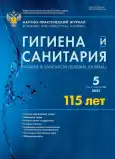Psychophysiological correction of occupation-related arterial hypertension
- 作者: Sheenkova M.V.1, Gavrilchenko D.S.1, Shirokov V.A.1, Podoprigora V.A.1, Novikova A.V.1
-
隶属关系:
- Federal Scientific Center of Hygiene named after F.F. Erisman
- 期: 卷 104, 编号 5 (2025)
- 页面: 562-567
- 栏目: OCCUPATIONAL HEALTH
- ##submission.datePublished##: 15.12.2025
- URL: https://rjsvd.com/0016-9900/article/view/689394
- DOI: https://doi.org/10.47470/0016-9900-2025-104-5-562-567
- EDN: https://elibrary.ru/qgddaj
- ID: 689394
如何引用文章
详细
作者简介
Maria Sheenkova
Federal Scientific Center of Hygiene named after F.F. Erisman
Email: sheenkova.mv@fncg.ru
Daria Gavrilchenko
Federal Scientific Center of Hygiene named after F.F. Erisman
Email: gavrilchenko.ds@fncg.ru
Vasily Shirokov
Federal Scientific Center of Hygiene named after F.F. Erisman
Email: shirokov.va@fncg.ru
Vera Podoprigora
Federal Scientific Center of Hygiene named after F.F. Erisman
Email: podoprigora.va@fncg.ru
Anna Novikova
Federal Scientific Center of Hygiene named after F.F. Erisman
Email: anna.v.novikova@mail.ru
参考
- Медведев Д.С., Туктаров А.М., Озорнина А.К., Шутович А.А., Обрезан А.Г. Совершенствование системы управления рисками, обусловленными артериальной гипертензией, на промышленных предприятиях. Кардиология: новости, мнения, обучение. 2025; 13(1): 11–6.
- Драпкина О.М., Концевая А.В., Калинина А.М., Авдеев С.Н., Агальцов М.В., Александрова Л.М. и др. Профилактика хронических неинфекционных заболеваний в Российской Федерации. Национальное руководство 2022. Кардиоваскулярная терапия и профилактика. 2022; 21(4): 5–232. https://doi.org/10.15829/1728-8800-2022-3235 https://elibrary.ru/dnbvat
- Полонская А.А., Горшунова Ю.С., Толмачев Д.А. Сердечно-сосудистые заболевания как медико-социальная проблема. Modern Science. 2021; (12–2): 110–4. https://elibrary.ru/dqtsaj
- Стрижаков Л.А., Бабанов С.А., Борисова Д.К. Артериальная гипертензия с позиции оценки профессиональных рисков. Профилактическая медицина. 2021; 24(1): 118–23. https://doi.org/10.17116/profmed202124011118 https://elibrary.ru/thsvrg
- Федоткина С.А., Хугаева Э.В. Анализ факторов риска развития сердечно-сосудистых заболеваний у лиц трудоспособного возраста. Социальные аспекты здоровья населения. 2022; 68(6): 5. https://doi.org/10.21045/2071-5021-2022-68-6-5 https://elibrary.ru/byxelk
- Чуранова А.Н., Горчакова Т.Ю. Смертность населения трудоспособного возраста в промышленных регионах Сибири. Медицина труда и промышленная экология. 2020; 60(11): 888–91. https://doi.org/10.31089/1026-9428-2020-60-11-888-891 https://elibrary.ru/vkzikc
- Бакиров А.Б., Шайхлисламова Э.Р., Волгарева А.Д., Каримова Л.К., Гимранова Г.Г. Результаты научно-исследовательских работ по оценке рисков здоровью работников при производственном воздействии физических факторов. Медицина труда и экология человека. 2021; (3): 7–13. https://elibrary.ru/ayxsgi
- Шур П.З., Зайцева Н.В., Фокин В.А., Кирьянов Д.А., Хасанова А.А. Методические подходы к оценке персонального профессионального риска здоровью, обусловленного болезнями, связанными с работой, на протяжении всего периода трудовой деятельности. Анализ риска здоровью. 2021: (1): 82–9. https://doi.org/10.21668/health.risk/2021.1.08 https://elibrary.ru/ybtyfs
- Жеглова А.В. Методология оценки профессионального риска работающих при воздействии физических факторов. Гигиена и санитария. 2021; 100(9): 975–9. https://doi.org/10.47470/0016-9900-2021-100-9-975-979 https://elibrary.ru/qdcbig
- Масягутова Л.М., Абдрахманова Е.Р., Габдулвалеева Э.Ф., Перминова В.А. Риск формирования профессиональной, производственно-обусловленной и общесоматической патологии у работников металлургических производств. Вестник Авиценны. 2021; 23(2): 280–90. https://doi.org/10.25005/2074-0581-2021-23-2-280-290 https://elibrary.ru/dfhpwu
- Широков В.А., Вараксин А.Н., Гаврильченко Д.С., Терехов Н.Л. Влияние физической активности на распространённость болезней системы кровообращения у работников промышленных предприятий. Гигиена и санитария. 2025; 104(2): 174–9. https://doi.org/10.47470/0016-9900-2025-104-2-174-179 https://elibrary.ru/bqpfbj
- Мясников И.О., Кизеев А.Н. Обзор рисков развития профессиональных и производственно-обусловленных заболеваний у работников горно-металлургических предприятий в АЗРФ. Российская Арктика. 2024; 6(3): 26–42. https://elibrary.ru/cwmkrc
- Яцына И.В., Жадан И.Ю., Шеенкова М.В., Красавина Е.К. Мультифакториальный подход к профилактике профессиональной и профессионально обусловленной патологии у работающих во вредных условиях труда. В кн.: Попова А.Ю., Кузьмин С.В., ред. Современные аспекты гигиены, токсикологии и профпатологии: Материалы Всероссийской научно-практической конференции с международным участием, посвященной 130-летию основания Федерального научного центра гигиены им. Ф.Ф. Эрисмана. Мытищи; 2021: 175–9. https://elibrary.ru/wovmcs
- Ушаков А.В., Иванченко В.С., Гагарина А.А. Патогенетические механизмы формирования стойкой артериальной гипертензии при хроническом психоэмоциональном напряжении. Артериальная гипертензия. 2016; 22(2): 128–43. https://doi.org/10.18705/1607-419X-2016-22-2-128-143 https://elibrary.ru/wcfftv
- Глибко К.В., Старокожева А.Я., Плотникова Н.А., Щепетин Н.В., Орлова Н.В., Никанорова Е.С. и др. Стресс-индуцированная артериальная гипертония в Рекомендациях ESH по ведению артериальной гипертензии 2023 года. Медицинский алфавит. 2024; (13): 52–6. https://doi.org/10.33667/2078-5631-2024-13-52-56 https://elibrary.ru/puabdl
- Глухов Д.В., Юшкова О.И., Капустина А.В. Оценка психофизиологического состояния работников управленческого аппарата и риски нарушения здоровья. Медицина труда и промышленная экология. 2023; 63(3): 193–9. https://doi.org/10.31089/1026-9428-2023-63-3-193-199 https://elibrary.ru/uvewer
- Касимова Н.К. Современные представления об артериальной гипертензии. Экономика и социум. 2023; (4–2): 593–6. https://doi.org/10.5281/zenodo.8004556 https://elibrary.ru/nmtqjr
- Бузина Т.С., Абдуллаева А.С. Индивидуально-психологические особенности больных, страдающих гипертонической болезнью: обзор литературы. Личность в меняющемся мире: здоровье, адаптация, развитие. 2024; 12(4): 355–64. https://doi.org/10.23888/humJ2024124355-364 https://elibrary.ru/tllrhl
- Секирин А.Б., Майбродская А.Е. Перспективы использования акустических бинауральных биений в терапии психосоматических заболеваний. Международный журнал прикладных и фундаментальных исследований. 2019; (12): 105–9. https://elibrary.ru/vhtunj
- Бакаева З.В., Шумов Д.Е., Якунина Е.Б., Старшинов Ю.П., Свешников Д.С., Торшин В.И. и др. Влияние музыки с эффектом бинауральных биений на параметры сердечного ритма человека в процессе дневного сна. Журнал неврологии и психиатрии им. С.С. Корсакова. 2021; 121(4–2): 31–5. https://doi.org/10.17116/jnevro202112104231 https://elibrary.ru/jqwmwa
- Pratt H., Starr A., Michalewski H.J., Dimitrijevic A., Bleich N., Mittelman N. A comparison of auditory evoked potentials to acoustic beats and to binaural beats. Hear. Res. 2010; 262(1–2): 34–44. https://doi.org/10.1016/j.heares.2010.01.013
- Lustenberger C., Patel Y.A., Alagapan S., Page J.M., Price B., Boyle M.R., et al. High-density EEG characterization of brain responses to auditory rhythmic stimuli during wakefulness and NREM sleep. Neuroimage. 2018; 169: 57–68. https://doi.org/10.1016/j.neuroimage.2017.12.007
- Shumov D.E., Sveshnikov D.S., Yakunina E.B., Bakaeva Z.V., Mankaeva O.V., Dorokhov V.B. The brain as an adaptive filter: auditory steady state response to sound stimuli containing binaural beats during human daytime nap. J. Evol. Biochem. Phys. 2022; 58(4): 1193–203. https://doi.org/10.1134/S0022093022040226
补充文件







